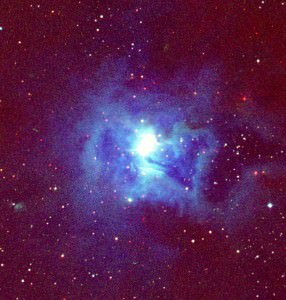Astronomers have managed to peer past obscuring dust clouds to gain their first peek at the gestation of a massive proto-star W33A which is about 12,000 light years away within the Sagittarius constellation. A spokesperson for the research team, who you may not be surprised to learn is British, described the sight as ‘reassuringly familiar, like a nice cup of tea’.
There has been a standing debate in astronomical circles about whether or not massive stars form in the same way as smaller stars. The issue has been hampered by a lack of observational data on just how massive stars form – as they develop so quickly they are generally only seen in an already fully formed state when they pop out of the obscuring dust clouds of their stellar nursery.
Known as a Massive Young Stellar Object (MYSO), W33A is estimated to be at least 10 solar masses and still growing. Shrouded in dust clouds it cannot be observed in visible light, but much of its infrared radiation passes through those ‘natal’ dust clouds. A research team led by Ben Davies from the University of Leeds collected this light using a combination of adaptive optics and the Near Infrared Integral Field Spectrograph (NIFS), on the Gemini North telescope in Hawaii.
The research team was able to piece together an image of a growing star within an accretion disk – surrounded by a wider torus (like a donut) of gas and dust. There were also clear indications of jets of material being blasted away from the poles of W33A at speeds of 300 kilometres a second. These are all common features that can be observed in the formation of smaller stars.

This adds to other recent findings about the formation of massive stars – including the Subaru Observatory’s direct imaging of a circumstellar disk around the MYSO called HD200775 reported in November 2009 and evidence of rapid formation of planets around massive stars in the W5 stellar nursery, reported by other researchers to the American Astronomical Society in January 2010.
These findings support the view that massive star formation occurs in much the same way as we see in smaller stars, where a centre of mass sucks up material from a surrounding gas cloud and the falling material collects into a spinning, circumstellar accretion disk – often accompanied by polar jets of material flung out by powerful electromagnetic forces within the growing star.
However, at least one clear distinction is apparent between small and massive star formation. The shorter wavelength, high energy radiation of newborn massive stars seems to dissipate the remains of their circumstellar disk more quickly than in smaller stars. This suggests that planet formation is less likely to occur around massive stars, although evidently some of them still manage it.


A phenomenological determined scaling principle for stellar formation. Nice, good work.
LC